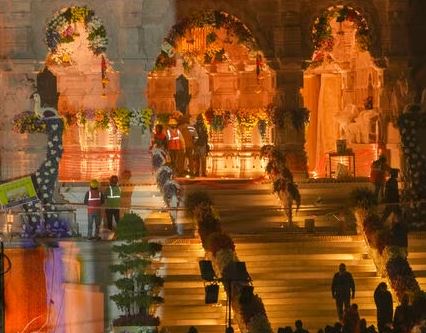Bhubaneswar: People across the country and in Odisha celebrated the historic consecration of the Ram temple at Ayodhya with pomp and show, and devotional programmes at various religious places.
Spontaneous celebrations in both rural and urban areas across Odisha marked the momentous occasion January 22.
So much so that the euphoria took the Opposition BJP in Odisha by surprise and it appeared very upbeat.
“We were not expecting the Ram temple consecration to get such a massive support from the people throughout the state. This will have an unprecedented impact on the forthcoming general elections, which will take everyone by surprise,” said Jatin Mohanty, General Secretary, BJP, Odisha.
The saffron party is planning to cash in on the widespread euphoria surrounding the consecration of the Ram temple among the people of the state.
It is pertinent to mention that the BJP had successfully leveraged the temple issue during the recently-concluded Assembly elections in Madhya Pradesh, Chhattisgarh and Rajasthan.
“Whatever political impact the Ram mandir issue is going to make, it will go in favour of the BJP, as everyone knows that the party is attached to the movement and has been supporting it for a long time,” added Mohanty.
Though he denied the need for the party to put in extra efforts to let people understand its contribution towards the Ram mandir movement, the BJP leader however added that the issue would naturally come up when the party workers interact with people in the run up to the elections.
Some experts also hold the same view, predicting a major gain for the saffron party in the elections due to the consecration of the Ram temple.
Political analysts assert that the BJP may win more seats in both, the Lok Sabha and state Assembly.
“The BJP workers are energised with the unprecedented response of the people, especially the impromptu celebrations in rural pockets on the occasion of the ‘Prana Pratishtha.’
“Though, the Ram mandir movement in the 1990s helped the BJP emerge as a major political power in India, yet it failed to make significant inroads in Odisha. However, this time the BJP succeeded in connecting people on the ground with the issue,” said veteran journalist Rabi Das.
Meanwhile, Surya Narayan Mishra, former head of department of Political Science at Utkal University, asserts that there is no doubt that the BJP has consolidated its traditional vote bank with the temple’s consecration.
He said that the BJP may also garner the support of some neutral voters who are unhappy with the present BJD Government.
Notably, the BJP won 23 seats in the 2019 Assembly elections while its vote share rose from 18.2 per cent in 2014 to 32.49 per cent in 2019. Significantly, the saffron party had managed to win only 10 seats in the 2014 Assembly elections.
Similarly, the BJP’s vote share increased to 38.4 per cent in the 2019 Lok Sabha polls as against 21.9 per cent in the 2014 general elections. The party grabbed eight Lok Sabha seats in 2019.
On the other hand, the BJD recorded a marginal decrease in its vote share in the 2019 Lok Sabha elections. The BJD received 44.8 per cent of the total votes in 2014 which dipped to 42.8 per cent in 2019.
Professor Mishra also cautioned that the people of Odisha have always voted intelligently without getting swayed by any political movements or caring for who was ruling the state during any elections.
“They have never voted on religious and caste lines and don’t get affected by any political movement. A closer scrutiny of voting patterns in the state for the past many decades makes it clear that the voters in Odisha have several times voted differently during the elections to the Lok Sabha and the state Assembly. This time, too, they may follow the same precedent. However, it is too early to predict conclusively,” Mishra added.
IANS
